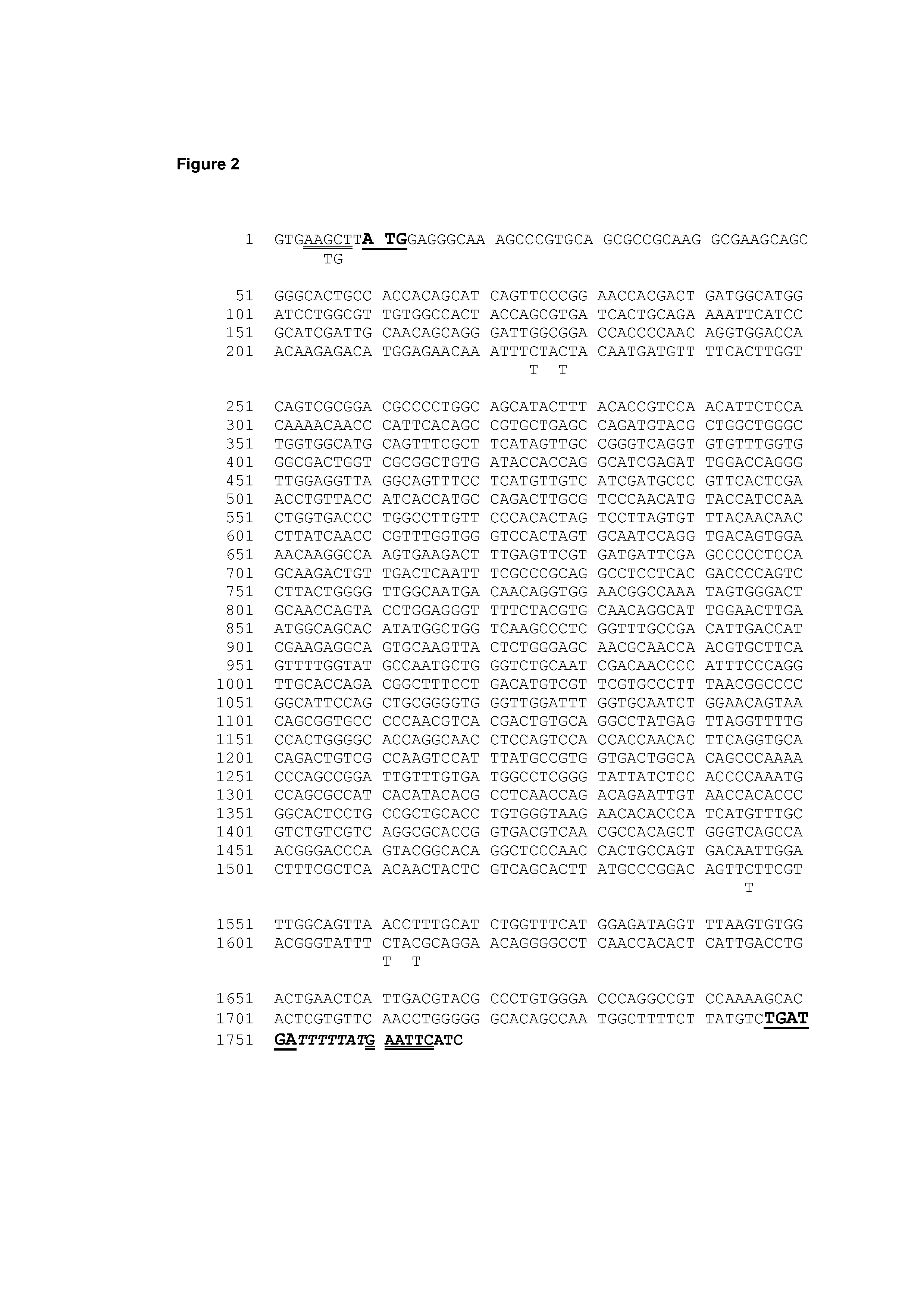Parapoxvirus expressing the vp60 major capsid protein of the rabbit haemorrhagic disease virus
a haemorrhagic disease virus and parapoxvirus technology, applied in the field of parapoxvirus expressing, can solve the problems of recombinant protein, high mortality rate in wild rabbits, significant economic losses in commercial rabbit production, etc., and achieve high attenuation, high attenuation, and inability to reproduce.
- Summary
- Abstract
- Description
- Claims
- Application Information
AI Technical Summary
Benefits of technology
Problems solved by technology
Method used
Image
Examples
example 1
VP60 DNA Sequence
[0069]In order to produce recombinant ORF viruses that express the VP60 protein of the RHDV (Rabbit Haemorrhagic Disease Virus), the entire VP60 gene (SEQ ID No. 1) was synthesised by the company “Mr. Gene” (Regensburg, Germany). In order to ensure correct expression of the recombinant VP60 the DNA sequence of the gene was optimised to remove early poxviral transcriptional stop motifs. The VP60 gene was provided in vector pMK-RQ, as shown in FIG. 1. The VP60 gene was isolated from the pMK-RQ plasmid by a HindIII-EcoR1 restriction digest and subsequently ligated into the transfer plasmid pDV-Rec1. The resulting plasmid was named pdV-VP60n. Correct insertion of the VP60 fragment was confirmed by DNA sequencing. See FIGS. 1 and 2 for a description of the VP60 DNA sequences.
example 2
Recombinant Virus Selection Strategy
[0070]Vero cells were infected with the beta-galactosidase (LacZ-gene positive) expressing ORFV strain D1701-VrV and subsequently transfected with the pdV-VP60n plasmid via nucleofection. After successful DNA recombination, the beta-galactosidase gene is exchanged by the VP60 gene of RHDV to generate white recombinant virus plaques that can be distinguished from the parental blue D1701-VrV strains.
[0071]VP60 gene positive plaques can therefore be identified using plaque-PCR after selection according to colour (FIG. 3, vp60). After plaques had been purified three times, LacZ PCR-negative recombinant viruses could be obtained (FIG. 3, LacZ) that contained the desired VP60 gene. The three recombinant viruses marked by boxes in FIG. 3 (3.3.4, 4.1.9, 2.2.6) were selected for further testing.
example 3
Immunostaining of Infected Cells for VP60 Expression
[0072]After propagation of the three plaque isolates, 3.3.4, 4.1.9 and 2.2.6, immunostaining of infected cells was carried out in order to test the expression of the VP60 protein. Either infected or uninfected cells were stained with a VP60-specific rabbit antiserum (FIG. 4, ni represents uninfected cells). In comparison to the uninfected cells (ni), all three isolates demonstrate comparably pronounced and specific staining of virus plaques.
PUM
| Property | Measurement | Unit |
|---|---|---|
| diameter | aaaaa | aaaaa |
| time | aaaaa | aaaaa |
| time | aaaaa | aaaaa |
Abstract
Description
Claims
Application Information
 Login to View More
Login to View More - R&D
- Intellectual Property
- Life Sciences
- Materials
- Tech Scout
- Unparalleled Data Quality
- Higher Quality Content
- 60% Fewer Hallucinations
Browse by: Latest US Patents, China's latest patents, Technical Efficacy Thesaurus, Application Domain, Technology Topic, Popular Technical Reports.
© 2025 PatSnap. All rights reserved.Legal|Privacy policy|Modern Slavery Act Transparency Statement|Sitemap|About US| Contact US: help@patsnap.com



